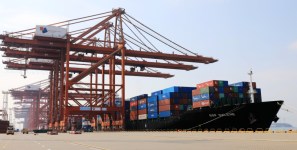HOW TO BE AN INTERMODAL SHIPPER OF CHOICE
Fluctuating capacity and freight rates along with increased focus on efficiency and sustainability have led to substantial growth in the intermodal market in recent years. As more companies now compete for intermodal capacity at competitive rates, it is important for shippers to set themselves apart from the competition by being attractive partners to their intermodal carriers.
By being a “shipper of choice” and implementing flexible and efficient practices, companies can build collaborative, mutually beneficial relationships with their intermodal carriers. This better positions them to secure capacity at stable, competitive pricing and enhance service levels and improve overall performance.
Why It’s Important to be an “Intermodal Shipper of Choice”
While being a “shipper of choice” has been a hot topic in recent years, the focus has primarily been placed on over-the-road shipping. And while there are many similarities between the two modes, there are also some nuances that must be considered to be an “intermodal shipper of choice” in particular.
First, because loads are tied to the equipment instead of to an individual driver, there must be an equal (if not greater) focus on equipment management and efficiency in addition to driver efficiency. By placing equal focus on implementing “carrier-friendly” tactics for intermodal freight, shippers can strengthen carrier relationships and better control costs. This, in turn, ensures enhanced intermodal service performance–increasing the ROI of utilizing the mode.
Here are some strategies organizations can use to become an intermodal shipper of choice:
Engage in annual renewals with incumbent carriers rather than annual RFPs. While annual RFPs can yield savings, they also increase uncertainty and risk for both shippers and carriers. By focusing on long-term commitments with incumbent carriers through annual renewals, shippers and their core carriers can continuously foster a relationship of mutual trust and ongoing success. Through this relationship, the carrier and its drivers become intimately familiar with the shipper’s network, freight and business, and the shipper gets to know the carrier’s operations and the drivers responsible for picking up and delivering their loads.
Accurately forecast freight volumes. The ability to forecast freight volumes and seasonal swings allows shippers and carriers to proactively plan (and reposition) equipment and drivers to provide adequate capacity. Sharing this information not only helps provide more consistent service but can be beneficial for both sides on an ongoing basis.
Consistent freight volumes. Having consistent volume spread out throughout the week, month or year makes appointment scheduling and equipment planning easier for the carrier. And if shippers do ship heavier at certain times, it is important to set and manage expectations with carriers.
Equipment pool requirements in line with volume. Pool requirements that are in line with volume allow shippers to turn boxes on a regular basis and keep loads moving at a consistent pace. This helps maximize equipment utilization while minimizing equipment costs.
Inbound and outbound volume. Setting consistent inbound and outbound volume out of facilities allows drivers to pick up loads immediately following a drop-off. This reduces empty miles and improves both driver and equipment utilization. These efficiencies will ultimately result in better rates from carriers.
Utilize drop and hook freight capabilities. Drivers want to be able to get in and out of a facility in an efficient manner, at any time. Drop and hook freight capabilities create load flexibility, reducing congestion in the yard and maximizing driver utilization by minimizing detention time.
Flexible pick-up and delivery appointments. For customers that require pick-up and delivery appointments, it is important to make them as flexible as possible. This drives further efficiencies for both the carrier and the shipper.
Reasonable payment terms. Shippers should have timely freight payment terms (often 30 days or fewer) and keep to those terms. It is also important to have a system in place to quickly resolve any discrepancies.
Provide driver amenities at the facilities. By providing driver amenities at their facilities (such as bathrooms or waiting lounges), shippers help make the pick-up and delivery process easier and more comfortable. These simple comforts show that the shipper views the carrier (and its drivers) as a valuable part of their operations versus a commodity.
Utilize facilities in close proximity to intermodal terminals. Facilities that are located near intermodal rail terminals allow rail to be a more competitive option for a shipper. While this is not always possible, shippers looking to build new facilities should consider placing them near rail ramps in order to take advantage of more intermodal opportunities.
Intermodal Presents Significant Opportunity for Shippers
Intermodal continues to be a cost-effective, efficient and sustainable way to move freight and should be a key piece of any strategic modal mix. And as more shippers compete for capacity and competitive rates, it’s important for shippers to best position themselves to be attractive partners to intermodal carriers. This will allow them to better take advantage of intermodal while helping to control costs and enhance service performance.
__________________________________________________
Doug Punzel is president of Celtic Intermodal, Transplace’s intermodal business unit. David Marsh serves as Celtic Intermodal’s chief operating officer and helps oversee all daily operations.





Leave a Reply